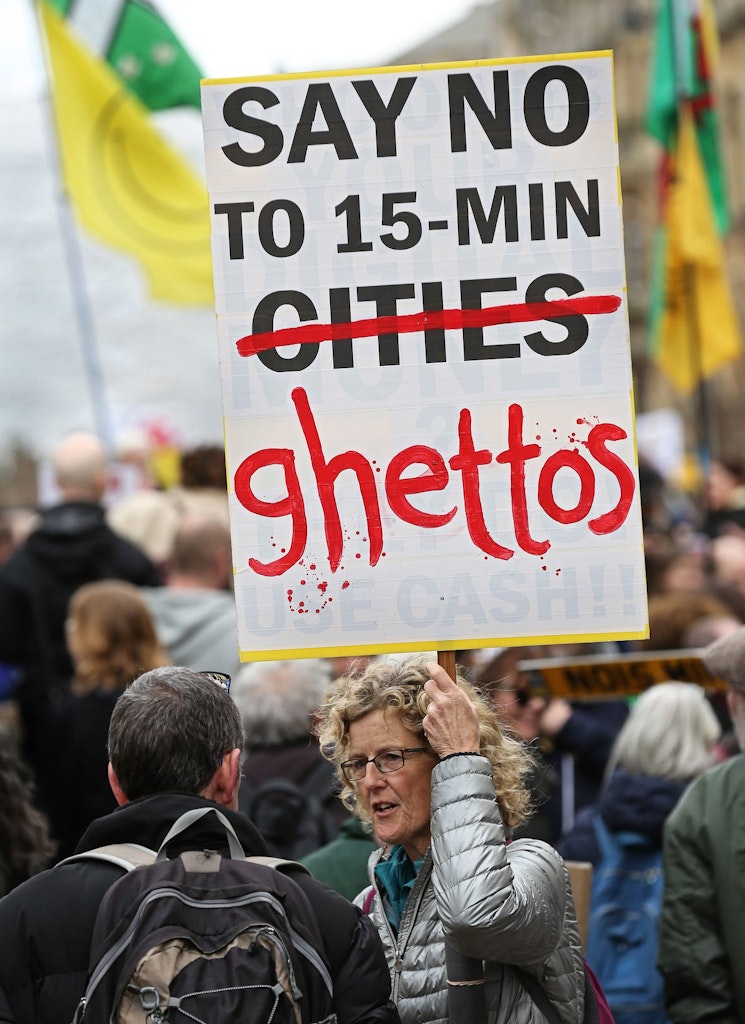The 15-minute bait and switch
15-minute cities mean restricted freedom and a town hall traffic-fine bonanza
This article is taken from the March 2024 issue of The Critic. To get the full magazine why not subscribe? Right now we’re offering five issues for just £10.
This time last year I watched with bemusement as a strange new trend emerged in my native Britain. Councils were introducing restrictions on citizens moving about by car. Living in Portugal had given me an observer’s detachment and I struggled to reconcile what I was seeing with the country I knew.
Oxford — my alma mater and the city where I regularly used to lose my bicycle — was at the heart of it. In November 2022, Oxfordshire County Council approved an experimental traffic scheme in a city notorious for congestion. Traffic filters would divide the city into zones, with those wishing to drive between them obliged to apply for permits.
Residents would be allocated passes for up to 100 journeys a year and those living outside the permit area 25. The zones would be monitored by automatic number plate recognition cameras and any journeys taken without permits would result in fines.
Duncan Enright, the councillor with responsibility for travel strategy told the Sunday Times the scheme would turn Oxford into a 15-minute city: “It is about making sure you have the community centre which has all of those essential needs, the bottle of milk, pharmacy, GP, schools which you need to have a 15-minute neighbourhood”.
The Central Oxfordshire Travel Plan made no provision for new services or even assessing existing amenities
The explanation didn’t make sense. The council was presenting a scheme centred around restrictions on the movement of vehicles on the basis of something quite different: the desirability of local facilities. It was part of a plan for a “net zero transport system” which included a commitment to “20-minute neighbourhoods: well-connected and compact areas around the city of Oxford where everything people need for their daily lives can be found within a 20-minute walk”.
Yet the Central Oxfordshire Travel Plan made no provision for new services or even assessing existing amenities. Instead, flourishing neighbourhoods were to be achieved by the simple expedient of making it difficult for people to drive across the city. Residents, visitors and businesses would make only “essential” — the word was highlighted in bold — car journeys. And while they would still be able to enter and exit Oxford via the ring road, “a package of vehicle movement restrictions” would “encourage” people to live locally.
Traffic management or social engineering? The council’s plan looked like a case of bait-and-switch: citizens were being enticed to accept one thing on the promise of another. And, judging by the increasing revenues other councils were collecting through cameras, the scheme would be a nice earner.

The vast amount of media coverage on 15-minute cities fuelled the fundamental confusion at the heart of the Oxford scheme. Instead of examining its implications, journalists characterised those questioning the proposals as “conspiracy theorists” who were wilfully refusing leafy roads and local markets. “What are 15-minute cities and why are anti-vaxxers so angry about them?” ran a headline in The Times.
The Guardian published a piece titled “In praise of the 15-minute city” which mocked “libertarian fanatics and the bedroom commentators of TikTok”, claiming they belonged to an “anti-vaccine, pro-Brexit, climate-denying, 15-minute-phobe, Great Reset axis”. What had happened to the newspaper I’d read for decades and on occasion written for, with its understanding of the effects of policies on ordinary people?
The public debate around the Oxford experiment completely bypassed the obvious practicalities. What about a typical family, juggling work with school runs and after-school activities? Having to drive out of the city and around its periphery for each trip could make their lives impossible. How would those whose work wasn’t accessible by public transport manage on the two permitted journeys a week?
Why did municipal officials have the right to decide whose journeys are “essential”?
Then there was the question of how Oxonians would transport heavy or cumbersome items. With careful planning, those who didn’t need to use their car for work might manage a trip to the tip or DIY store without going the long way round. But how would such arrangements affect musicians taking instruments to gigs across town? Would enough drivers be willing to use their allowance to take games to Scout and Brownie groups and tools to community gardening sessions?
Putting such points to advocates of the measures on social media invariably engendered the same response: no one would be prevented from going anywhere. All people had to do was get on their bikes; heavy items could easily be transported via cargo bikes. The fact that the age, health or distance ruled out cycling for many went entirely unacknowledged. With a vocal minority supporting restrictions on their fellow citizens, it was clear that something more than enthusiasm for traffic-calming was playing out. A new ideology was emerging.
* * * * *
The origins of Britain’s anti-vehicle movement are both international and domestic. The concept of a 15-minute city goes back to 2015 when Sorbonne professor Carlos Moreno coined the term at COP21. Together with its sister, 20-minute neighbourhoods, the idea is that everything the city-dweller needs should be available within a short walk or bike ride.
A fundamental shift in the power of the state to regulate how people lived their lives was under way
Moreno was not alone in arguing that Covid had created an opportunity to reorganise urban life. In May 2020, an article by a Reuters journalist on the website of the international NGO, The World Economic Forum, called for the transformation of post-pandemic cities so that residents lived, worked and played within a small area. The idea was supported by UN-Habitat, non-government organisations and universities.
Paris’s mayor, Anne Hidalgo, championed the idea in her election campaign, while the 20-minute neighbourhood was already part of the plan for the Australian city of Melbourne. In Britain, the idea of “liveability” dovetailed with the road closures that began under Covid.
In early 2020, the government provided local authorities with funding for planters to encourage social distancing. Subsequent Active Travel grants were made available to tackle congestion, with councils using Experimental Traffic Regulation Orders to close roads. Returning to Britain after two years away, I was surprised to see the very planters that had borne the Covid-19 signage repurposed for Low Traffic Neighbourhoods.
I was struck by how far Britain had departed from its historically reasonable approach to policymaking. As a public policy journalist in the early 2000s, I often followed the passage of innovative schemes from inception to implementation. Government departments tended to proceed with caution, consulting widely, aware that unintended consequences might create a situation worse than the one the policy aimed to remedy.
Councils keen on trendy concepts such as “localism” knew they didn’t have the power or funds to do much and confined themselves to awarding modest grants to community projects. By contrast, councils were now assuming power of a completely different order over public space. Why did municipal officials have the right to decide whose journeys are “essential”?
A year on, Oxford remains at the heart of Britain’s car wars
A closer look at the Oxford scheme heightened my concerns. Exemptions would be given to a “qualifying car club” while a “non-professional carer would be allowed through ‘one traffic filter’”. Health and care workers would be permitted to take the quickest route for “operational journeys”, but not to travel to and from work.
A fundamental shift in the power of the state to regulate how people lived their lives was under way, one that eroded not the principle but the practicality of the freedoms of movement and association. Enforcement would require an unprecedented level of surveillance, with cameras on street corners and at the borders of artifically-created zones.
And it was happening without public debate. An attempt by Nick Fletcher MP to hold a parliamentary debate on the subject was met with a slew of articles condemning him as a conspiracy theorist. A statement from the Department for Levelling Up, Housing and Communities in response to a March 2023 petition echoed the oxymoronic formulation “restriction gives you choice” I had heard elsewhere: “15-minute cities aim to provide people with more choice about how and where they travel, not to restrict movement.”
A year on, Oxford remains at the heart of Britain’s car wars. Last October, despite ongoing protests, three LTNs in the east of the city were made permanent. They have been blamed for damaging local businesses and teacher recruitment, increasing ambulance response times and bus journeys. New campaign groups post footage of gridlocked roads on social media daily.
In the meantime, it looks as if the government is changing its tune. “I’m calling time on the misuse of so-called 15-minute cities,” declared transport secretary Mark Harper at the Tory conference. “We shouldn’t tolerate the idea that local councils can decide how often you go to the shops and ration who uses the road and when and then police it all with CCTV”.
Oxford’s plan, partly funded by the Department of Transport, to zone the city is due to begin in the autumn for a trial of six to 18 months. And on 29 February the father of the 15-minute city, Carlos Moreno, will give the annual lecture at Oxford University’s Transport Studies Unit on the idea’s origins and potential.
Moreno has dismissed the concerns of critics. “Their lies are enormous,” he told the author of a Forbes article: “You will be locked in your neighbourhood; cameras will signal who can go out; if your mother lives in another neighbourhood, you will have to ask for permission to see her and so on.”
Will his vision of the 15-minute city deliver on its life-enhancing promises? Oxford is soon to find out. I will be watching with interest.
Enjoying The Critic online? It's even better in print
Try five issues of Britain’s most civilised magazine for £10
Subscribe














